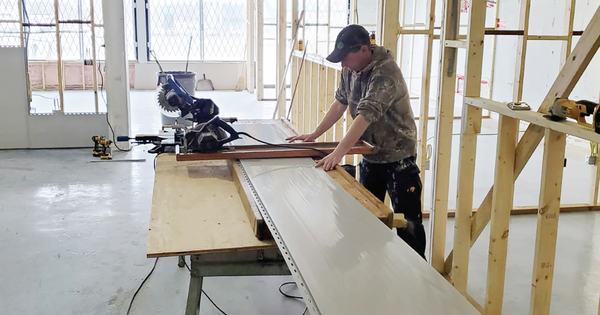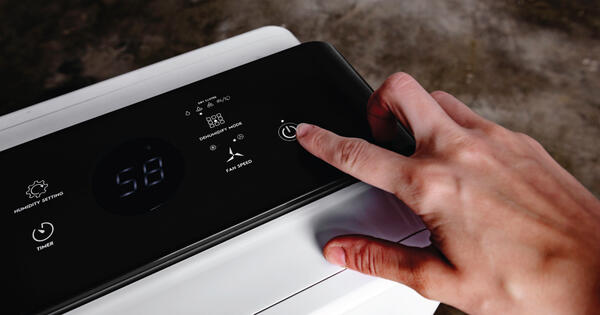Heating your garage might not seem like a top priority, but when winter rolls around, you'll be thankful you thought ahead and created a cozy space to work on your projects or keep your vehicles safe from the chill. In this blog post, we'll explore the best ways to heat your garage, from electric heaters to radiant floor heating, helping you create a comfortable and functional space even in the coldest months.
Benefits of Installing Garage Heaters
Heating a garage during cold seasons is important for several reasons, primarily to protect vehicles and enhance workspace comfort. These are the three key benefits:
- Protecting Vehicles: Maintaining a heated garage helps prevent damage caused by extreme cold, such as thickened fluids, battery drainage, and difficulty starting the engine, ensuring your vehicles remain in optimal condition.
- Creating a Comfortable Workspace: With a heated garage, DIY enthusiasts can enjoy a more comfortable environment for projects like car maintenance, woodworking, and machinery tinkering, enhancing productivity and overall satisfaction.
- Preventing Moisture Buildup: Heating the garage helps prevent moisture accumulation, reducing the risk of mold, mildew, and rust formation on vehicles and stored items, particularly important in colder climates prone to condensation.



Different Types of Garage Heaters
When it comes to heating your garage, you've got several options to consider, each with its own advantages and considerations. Let's take a look at some of the most common heating options at-a-glance:
- Electric Heaters: These are popular for their ease of use and relatively low installation costs. Electric heaters come in various forms, including portable units, wall-mounted models, and even infrared heaters. They're typically efficient for smaller spaces but may lead to higher utility bills over time compared to other options.
- Propane Heaters: Propane heaters are a popular choice for garages without access to natural gas lines. They provide reliable heat and are available in portable or fixed models. However, you'll need to ensure proper ventilation to prevent carbon monoxide buildup, and you'll have the added expense of refilling propane tanks periodically.
- Gas Heaters: Natural gas heaters are efficient and cost-effective for larger garages connected to a gas line. They offer consistent heat and can be either wall-mounted or suspended from the ceiling. Like propane heaters, proper ventilation is essential to prevent carbon monoxide buildup.
- Radiant Floor Heating: This option involves installing heating elements beneath the garage floor, providing even heat distribution and eliminating the need for bulky heaters taking up space. While installation costs can be higher, radiant floor heating offers energy efficiency and long-term cost savings, making it a popular choice for those planning extensive garage renovations.
Each heating option has its own set of pros and cons, so it's essential to consider factors like your budget, the size of your garage, local climate conditions, and any specific preferences you may have before making a decision.
Best Electric Heaters for Garages
Electric heaters convert electrical energy into heat, providing warmth to a space like a garage. They come in various types, each offering specific features and suitability for different garage sizes and heating needs.
For garages, infrared heaters, forced-air heaters, and portable electric heaters are commonly used. Here's how they compare:
| Infrared Heaters | Forced-Air Heaters | Portable Electric Heaters | |
|---|---|---|---|
| Description |
Infrared heaters emit infrared radiation, which directly heats objects and surfaces in the garage rather than heating the air. |
Forced-air heaters, also known as fan-forced heaters, use a fan to circulate air overheating elements, distributing warmth throughout the garage. | Portable electric heaters are standalone units that can be moved around the garage as needed for spot heating or supplemental warmth. |
| Suitability | Targeted heating within a garage, ideal for spot heating or heating workstations. | Larger areas or entire garages, providing rapid and uniform heating. | Smaller garages or for providing localized heating to specific areas within larger spaces. |
| Operation | Emit infrared radiation, which is absorbed by objects and surfaces in the garage, warming them directly. | Draw air over heated elements, such as electric coils or ceramic heating elements, then blow the warmed air into the garage space using a fan. | Use electric resistance heating elements to generate warmth, which is distributed into the surrounding area using a built-in fan or radiant heating technology. |
| Installation | Can be wall-mounted or ceiling-mounted, depending on the specific model. | Can be wall-mounted or ceiling-mounted, depending on the specific model and layout of the garage. They require proper ventilation and clearance to operate safely. | Require no permanent installation and can be plugged into a standard electrical outlet. |
| Energy Efficiency | Can be energy-efficient because they heat objects directly, but their efficiency may vary depending on factors like insulation levels and garage size. | Can be energy-efficient if equipped with adjustable thermostats and fan speeds to optimize energy usage. |
Varies depending on factors like size, design, and usage patterns. Look for models with energy-saving features such as programmable thermostats and adjustable heat settings. |
| Cost Considerations | Initial costs may be higher than some types of electric heaters, but they can offer energy savings over time due to their focused heating capabilities. | Initial costs vary depending on the size and capacity of the unit. Consideration should be given to operational costs, including electricity usage for running the fan. |
Generally affordable and easy to purchase, but operational costs can add up over time, especially if used extensively. |
Best Propane Heaters for Garages
Propane heaters are heating devices that use propane gas as a fuel source to generate heat, making them a popular choice for heating garages that lack access to natural gas lines. They come in various types and sizes to accommodate different garage sizes and heating requirements.
Portable, wall-mounted, and ceiling-mounted propane heaters are popular for garages.Here's how they compare:
| Portable Propane Heaters | Wall-Mounted Propane Heaters | Ceiling-Mounted Propane Heaters |
|
|---|---|---|---|
| Description |
Portable propane heaters are standalone units that can be moved around the garage as needed for spot heating or supplemental warmth. |
Wall-mounted propane heaters are installed directly onto the wall, providing efficient heating while saving floor space in the garage. | Ceiling-mounted propane heaters are suspended from the ceiling, offering even distribution of heat throughout the garage. |
| Suitability | Smaller garages or for providing localized heating to specific areas within larger spaces. | Medium to large-sized garages where floor space is limited or where targeted heating is desired. | Larger garages or workshops where uniform heating is desired. |
| Operation | Feature a propane tank that connects to a unit where the gas is ignited to produce heat. Some models use radiant heating technology, while others use forced-air systems. | Feature a vented design that draws in outside air for combustion and vents exhaust gases outdoors. They use propane gas as a fuel source, which is ignited to produce heat. | Work similarly to wall-mounted models, using propane gas as a fuel source to produce heat and typically feature a vented design for safe combustion and exhaust ventilation. |
| Installation | Require no permanent installation and can be set up wherever heating is needed. | Require proper mounting to ensure stability and safety. Professional installation is recommended to ensure proper ventilation and gas line connections. | Require proper suspension from the ceiling structure to ensure stability and safety. Professional installation is recommended to ensure proper mounting and ventilation. |
| Energy Efficiency | Can vary depending on size, design, and usage patterns. Look for models with adjustable heat settings and built-in safety features to optimize efficiency. | Can be energy-efficient, especially if equipped with adjustable thermostats and programmable settings to optimize energy usage. |
Can be energy-efficient, especially when combined with zoning controls and programmable thermostats to optimize energy usage. |
| Cost Considerations | Generally affordable and offer flexibility for heating specific areas of the garage. However, operational costs can add up over time, especially if propane refills are required frequently. | Initial costs may be higher than portable models due to installation requirements, but they offer efficient heating and can help save space in the garage. | Initial costs may be higher due to installation and mounting requirements, but they offer efficient heating and can provide long-term savings on utility bills. |
Best Gas Heaters for Garages
Gas heaters are heating devices that use either natural gas or propane gas as a fuel source to generate heat, making them effective options for heating garages with access to gas lines or propane tanks. Here's how natural gas and propane gas heaters compare:
| Natural Gas Heaters | Propane Gas Heaters | |
|---|---|---|
| Description |
Natural gas heaters use a constant supply of natural gas from a utility line to produce heat. |
Wall-mounted propane heaters are installed directly onto the wall, providing efficient heating while saving floor space in the garage. |
| Suitability | Ideal for garages connected to a natural gas supply line, providing continuous and cost-effective heating. | Suitable for garages where natural gas is not available, providing reliable and portable heating. |
| Operation | Ignite natural gas to produce heat, which is distributed throughout the garage using a vented or vent-free system. | Ignite propane gas to produce heat, which is distributed throughout the garage using a vented or vent-free system. |
| Installation | Require professional installation to ensure proper connection to the gas line and ventilation for combustion gases. | Can be installed by connecting them to a propane tank, which may require professional installation or DIY setup depending on the complexity of the system. |
| Energy Efficiency | Generally more energy-efficient than electric heaters, offering cost savings over time due to lower fuel costs. | Can be energy-efficient, but operational costs vary depending on propane prices and usage. |
| Cost Considerations | May be higher due to installation requirements, but operational costs are typically lower compared to electric heaters. | May include the purchase of the heater and installation of the propane tank. Operational costs will depend on propane prices and usage patterns. |
Radiant Floor Heating
Radiant floor heating is a method of heating that involves installing heating elements beneath the floor surface to emit heat upward, warming the room from the ground up. These heating elements are typically either electric resistance cables or water-filled pipes.
The benefits of radiant floor heating include:
- Even Heat Distribution: Radiant floor heating provides consistent warmth across the entire floor surface, eliminating cold spots commonly experienced with traditional heating systems like forced air or baseboard heaters.
- Comfort: Because radiant floor heating warms objects and surfaces directly, rather than just the air, it creates a more comfortable environment with fewer drafts and fluctuations in temperature.
- Space Saving: Radiant floor heating systems are installed beneath the floor, freeing up wall space that would otherwise be occupied by radiators or vents, allowing for more flexibility in room layout and design.
- Energy Efficiency: Radiant floor heating can be more energy-efficient than traditional heating systems, as it operates at lower temperatures and doesn't suffer from heat loss through ductwork or inefficient distribution.
- Improved Indoor Air Quality: Unlike forced-air heating systems, radiant floor heating doesn't circulate dust, allergens, or other airborne particles, leading to better indoor air quality and reducing the risk of respiratory issues.
- Quiet Operation: Radiant floor heating systems operate silently, without the noise associated with fans or blowers found in forced-air systems, providing a peaceful and comfortable living environment.
- Longevity: Properly installed radiant floor heating systems can last for decades with minimal maintenance, offering long-term reliability and durability.

Energy Efficiency and Cost Considerations When Choosing a Heater
When selecting a heating system for your garage, consider both initial costs and long-term energy efficiency. While some systems may have higher upfront expenses, they can result in significant savings on utility bills over time.
| Initial Costs | Operational Costs | Long-Term Savings |
|---|---|---|
|
Budget: Determine your budget for purchasing and installing a heating system. While some options may have higher upfront costs, they may offer greater energy efficiency and long-term savings. Installation Requirements: Consider any additional installation costs, such as ductwork, wiring, or ventilation, which may vary depending on the heating system you choose. Available Incentives: Research available rebates, tax credits, or incentives for energy-efficient heating systems, which can help offset initial costs and improve the return on investment. |
Fuel Type: Compare the cost of different fuel sources, such as electricity, natural gas, propane, or heating oil, and choose the most cost-effective option based on local utility rates. Energy Efficiency: Look for heating systems with high energy efficiency ratings, such as ENERGY STAR® certified models, which can significantly reduce operational costs over time. Zoning and Programmable Controls: Opt for heating systems with zoning capabilities and programmable thermostats, allowing you to heat specific areas of your home only when needed, further reducing energy consumption and costs. |
Energy Savings: Calculate potential energy savings over the lifespan of the heating system by comparing its efficiency rating and estimated annual fuel consumption to less efficient alternatives. Maintenance Costs: Consider the long-term maintenance requirements and associated costs of each heating system. Some options may require more frequent servicing or repairs, impacting overall savings. Expected Lifespan: Evaluate the expected lifespan of the heating system and compare it to the initial investment and potential energy savings to determine the overall cost-effectiveness. |
For reference, here's how these associated costs compare across different types of heaters:
- Electric Heaters: Generally have lower upfront costs but may result in higher operational costs over time, especially in areas with expensive electricity rates.
- Natural Gas or Propane Heaters: May have higher initial costs for installation but offer lower operational costs compared to electric heaters, resulting in potential long-term savings.
- Radiant Floor Heating: Typically has higher upfront installation costs but can provide significant energy savings and improved comfort over the long term due to efficient heat distribution.
By carefully considering initial costs, operational costs, and long-term savings associated with different heating options, you can select an energy-efficient heating system that meets your needs while minimizing utility bills and maximizing overall savings.
Safety Measures to Take When Installing a Garage Heater
Safety is paramount when using garage heaters to ensure the well-being of yourself, your family, and your property. Here are some essential safety measures to follow when using garage heaters:
- Proper Ventilation: Ensure adequate ventilation in the garage to prevent the buildup of carbon monoxide (CO) and other harmful gases. Never use propane or gas heaters in enclosed spaces without proper ventilation.
- Carbon Monoxide Detectors: Install carbon monoxide detectors in your garage and adjacent living spaces to alert you to any buildup of CO. Test the detectors regularly and replace batteries as needed.
- Clearance: Maintain proper clearance around the heater to prevent combustible materials from coming into contact with hot surfaces. For example, all sources of radiant heat must be shielded and have at least 24 inches of clearance when installed alongside Trusscore Wall&CeilingBoard. Always follow the manufacturer's recommendations for minimum clearance distances.
- Stable Placement: Place portable heaters on stable, level surfaces to prevent tipping over. Keep them away from foot traffic and areas where they can be knocked over easily.
- Supervision: Never leave heaters unattended while in operation, especially if they are portable or have open flames. Turn off heaters when leaving the garage or going to sleep.
- Keep Flammable Materials Away: Store flammable liquids, fabrics, and other materials away from heaters to reduce the risk of fire. Ensure that any combustible materials are stored in designated areas away from heating sources.
- Child and Pet Safety: Keep children and pets away from heaters to prevent accidental burns or injuries. Install barriers or safety gates if necessary to restrict access.
- Regular Inspections: Inspect heaters regularly for signs of damage, wear, or malfunction. Look for frayed cords, loose connections, or unusual smells, and discontinue use if any issues are found.
- Follow Manufacturer's Instructions: Read and follow the manufacturer's instructions for installation, operation, and maintenance of your heater. Pay attention to any warnings or safety precautions provided.

How to Maintain and Inspect Garage Heaters
Regular maintenance and inspections are also essential to ensure safe operation and prevent potential hazards:
- Cleanliness: Keep heaters clean and free of dust, debris, and obstructions that can impede airflow or cause overheating. Wipe down exterior surfaces regularly and vacuum internal components as needed.
- Filter Replacement: If your heater has a filter, inspect and clean or replace it according to the manufacturer's recommendations to ensure proper airflow and efficient operation.
- Professional Inspections: Schedule regular inspections and maintenance by a qualified HVAC technician to identify and address any issues before they escalate. This may include checking for gas leaks, inspecting electrical components, and verifying proper operation.
- Safety Checks: Test safety features such as tip-over switches, overheat protection, and flame sensors to ensure they are functioning correctly. Replace any faulty components promptly.
- Documentation: Keep records of maintenance and inspections, including dates, services performed, and any repairs or replacements made. This documentation can help track the heater's performance and identify trends or recurring issues.
By following these safety measures and maintenance guidelines, you can use garage heaters safely and effectively, providing reliable warmth while minimizing the risk of accidents, injuries, or damage.
Heating your garage doesn't have to be a daunting task. By exploring the various heating options available, considering factors such as efficiency, cost, and safety, you can create a comfortable and functional space to enjoy year-round. Assess your specific needs and choose the heating system that best suits your garage and lifestyle, ensuring a warm and inviting environment for all your projects and activities.






